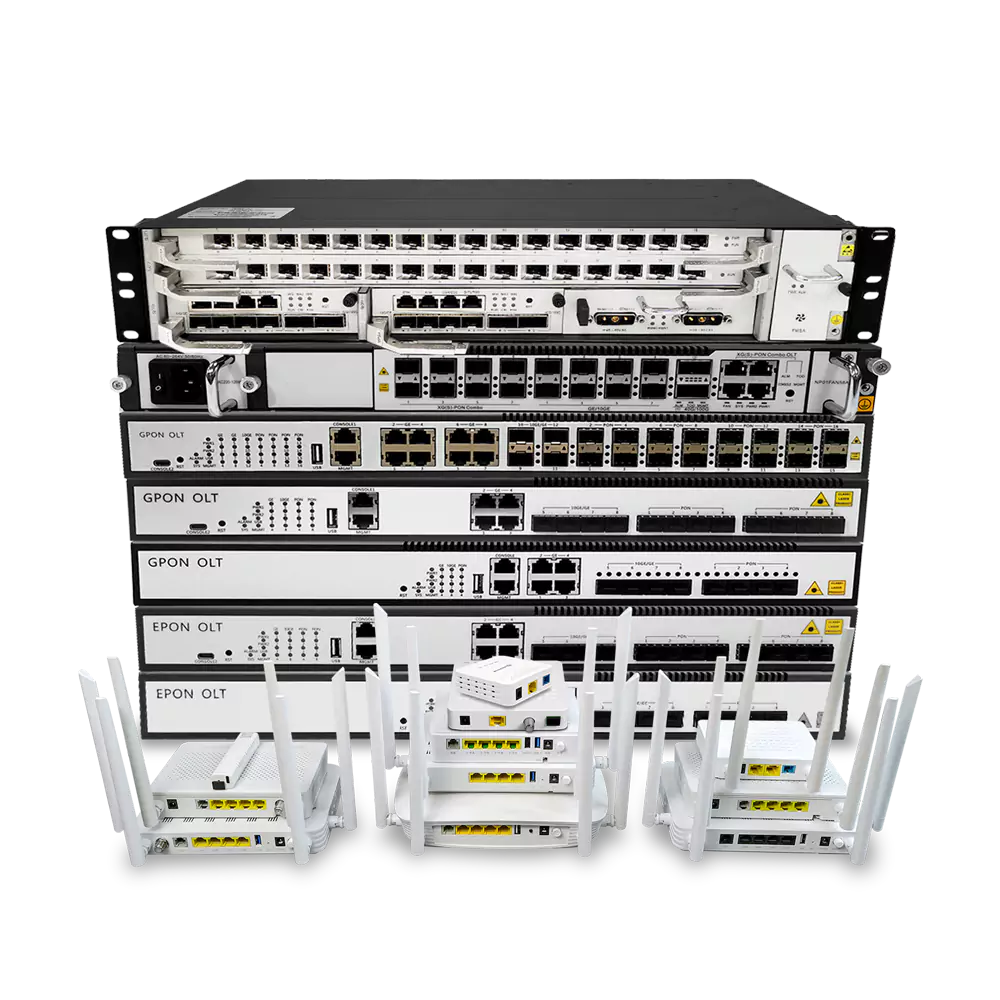Optical modules come in various types based on factors such as application scenario, transmission speed, transmission distance, and interface type. Each type of optical module has distinct features and use cases. Here’s an overview of the main types of optical modules and their differences:
1. By Data Rate
Optical modules are categorized based on the supported data transmission rate:
1G Optical Module (SFP)
- Data Rate: Supports a transmission rate of 1 Gbps.
- Common Interface: SFP (Small Form-factor Pluggable).
- Use Cases: Low-speed Ethernet or Fiber Channel applications.
10G Optical Module (SFP+)
- Data Rate: Supports a transmission rate of 10 Gbps.
- Common Interface: SFP+ (Enhanced Small Form-factor Pluggable).
- Use Cases: 10 Gigabit Ethernet, high-speed data center interconnections.
40G Optical Module (QSFP+)
- Data Rate: Supports a transmission rate of 40 Gbps.
- Common Interface: QSFP+ (Quad Small Form-factor Pluggable Plus).
- Use Cases: High-speed network switches, data center interconnections.
100G Optical Module (QSFP28)
- Data Rate: Supports a transmission rate of 100 Gbps.
- Common Interface: QSFP28 (Quad Small Form-factor Pluggable 28).
- Use Cases: High-speed data center interconnections, core routers, server-to-server connections.
400G Optical Module (QSFP56)
- Data Rate: Supports a transmission rate of 400 Gbps.
- Common Interface: QSFP56 (Quad Small Form-factor Pluggable 56).
- Use Cases: Ultra-high-speed data centers, cloud computing, high-performance computing (HPC).
2. By Transmission Distance
Optical modules are also classified based on the maximum transmission distance they support, with the following categories:
Short-Range Modules (SR)
- Transmission Distance: Typically used for multi-mode fiber, with distances ranging from a few hundred meters to 2 kilometers.
- Use Cases: Short-range connections, such as within data centers or in-rack switches.
- Common Types: SFP+ SR, QSFP+ SR4, QSFP28 SR4.
Long-Range Modules (LR)
- Transmission Distance: Typically used for single-mode fiber, with distances ranging from 10 km to 20 km or more.
- Use Cases: Suitable for metropolitan area networks (MANs) or long-distance connections.
- Common Types: SFP+ LR, QSFP+ LR4, QSFP28 LR4.
Extended-Range Modules (ER/EX)
- Transmission Distance: Typically used for single-mode fiber, with very long transmission distances, such as 40 km, 100 km, or even more.
- Use Cases: Long-distance wide-area network (WAN) connections, optical transport links.
- Common Types: QSFP28 ER4, QSFP56 ER4.
3. By Fiber Type
Optical modules are classified based on the type of optical fiber they are designed to work with:
Single-Mode Optical Modules (SMF)
- Use Case: Designed for single-mode fiber, where the optical signal travels along a single path, suitable for long-distance transmission.
- Common Types: SFP+ LR, QSFP28 LR4.
Multi-Mode Optical Modules (MMF)
- Use Case: Designed for multi-mode fiber, where the optical signal travels along multiple paths, suitable for short-distance transmission.
- Common Types: SFP+ SR, QSFP+ SR4.
4. By Transmission Mode
Optical modules can be classified by their transmission mode, typically including:
- CWDM (Coarse Wavelength Division Multiplexing)
- Definition: Coarse Wavelength Division Multiplexing modules allow multiple wavelengths of light to be transmitted over a single fiber.
- Use Cases: Suitable for multi-wavelength transmission, used to increase network capacity.
- DWDM (Dense Wavelength Division Multiplexing)
- Definition: Dense Wavelength Division Multiplexing modules use closely spaced wavelengths, supporting more channels compared to CWDM.
- Use Cases: High-density wavelength division multiplexing for long-distance and high-capacity transmission.
5. By Interface Type
Optical modules can also be categorized by their interface type, determining compatibility with different networking devices:
SFP (Small Form-factor Pluggable)
- Use Case: Typically used for 1 Gbps to 10 Gbps data rates, commonly used in low-speed Ethernet and fiber channel applications.
SFP+
- Use Case: Used for 10 Gbps transmission rates, widely used in 10 Gigabit Ethernet, Fiber Channel, etc.
QSFP+
- Use Case: Used for 40 Gbps transmission rates, typically used in data centers and high-speed network interconnections.
QSFP28
- Use Case: Used for 100 Gbps transmission rates, commonly used in high-speed data centers and core router interconnections.
QSFP56
- Use Case: Used for 400 Gbps transmission rates, widely used in ultra-high-speed data centers and cloud computing.
6. By Standard Type
Optical modules can also be classified based on the specific optical networking standards they adhere to:
- GPON/EPON Optical Modules
- Use Case: These are used for Passive Optical Networks (PON), including GPON (Gigabit Passive Optical Network) and EPON (Ethernet Passive Optical Network).
- OTN Optical Modules
- Use Case: Used for Optical Transport Networks (OTN), suitable for long-distance, high-capacity fiber transmission.
Summary:
The types of optical modules vary greatly, and selecting the right one depends on several factors: data rate, transmission distance, fiber type, interface type, and application scenario. Understanding the differences between optical modules helps in choosing the most appropriate module for a given network requirement.

